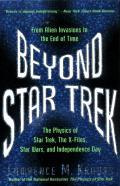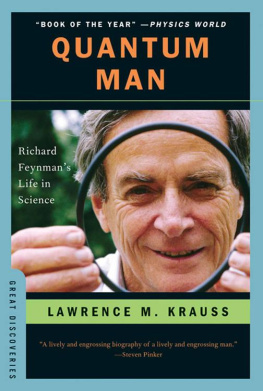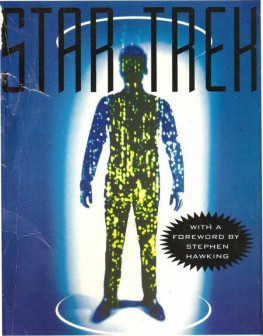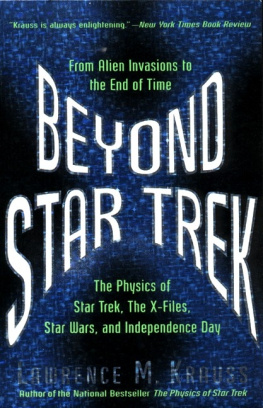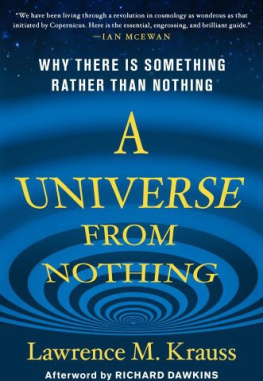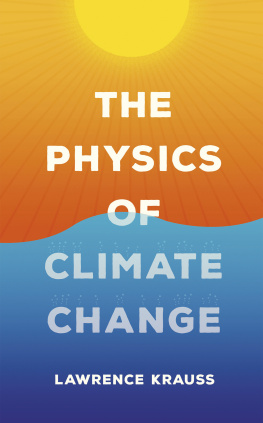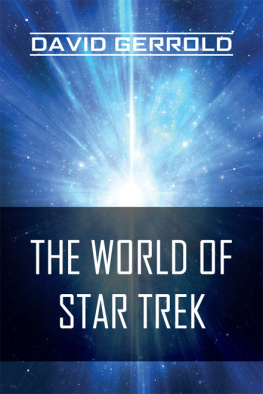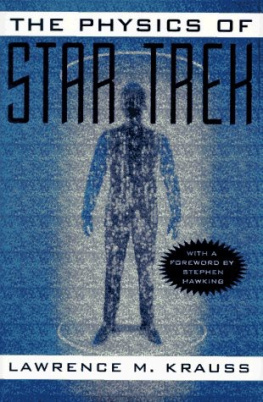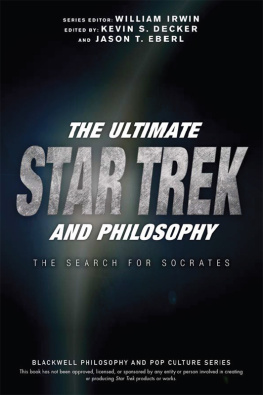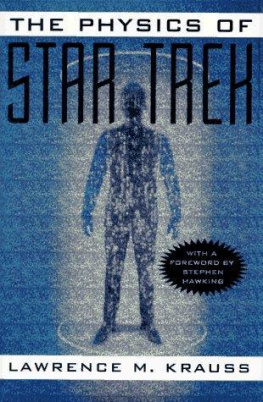BEYOND STAR TREK. Copyright 1997 by Lawrence M. Krauss. All rights reserved. Printed in the United States of America. No part of this book may be used or reproduced in any manner whatsoever without written permission except in the case of brief quotations embodied in critical articles and reviews. For information address HarperCollins Publishers, Inc., 10 East 53rd Street, New York, NY IOO2Z.
FIRST EDITION
Designed by Elliott Beard
Library of Congress Cataloging-in-Publication Data Krauss, Lawrence Maxwell.
Beyond Star Trek : Physics from alien invasions to the end of time / by Lawrence M. Krauss. 1st ed.
p. cm.
Includes index.
ISBN0-465-00637-X
1. Space sciences. 2. Life on other planets. 3. Space flight. I. Title
QB500.K64 1997
oo1.9'01'53dczi 97-31127
97 98 00 01 / R R D 10 9 8 7 6 5 4 3 2 1
In Memory of Carl Sagan
1934-1996
PROLOGUE
These are the days of miracle and wonder.
Paul Simon
I have been asked innumerable times since the publication of my last book, The Physics of Star Trek, to talk about the relationship of science to science fiction. I think the connection is a simple one: We are all inspired by the same questions. I also believe that the questions that scientists and writers of science fiction wonder about are essentially universal and time invariant. They are the subject of every age's fascination, reflected in its literature, art, and drama, and its science. The specific miracles change with time, as we learn about the world; as certain mysteries are unveiled, others are born. Think about a vibrant flower. Could such a wonderful thing really have evolved from primordial sludge? Yes. But let's go beyond this rather tired question and examine the flower further. It may have a beautiful pattern visible only in ultraviolet light, which a bee can sense. Who ordered that? Or think about the myriad chemical reactions going on in the bee's eye, which turn individual packets of pure energy into the same visual picture each time the bee scans the flower, in spite of the fact that these reactions are governed by probabilistic laws and the very molecules that respond to the light cannot be said even to exist in any specific state before, and sometimes after, absorbing the light. Deep inside the bee's brain and our own, the mysterious quantum-mechanical universe turns into the classical, predictable universe. How? And why are we self-aware and not the bee? Do we represent the only full consciousness in the universe? Are there extraterrestrial intelligences conscious of us now? How will we ever know?
All the miracles of our own existence and others' can be expressed in scientific terms. But the issues are just as engaging to anyone who simply wonders, "What if... ?" However, while the best science fiction arouses our interest by capturing the drama and excitement inherent in the "What if... ?" questions, it generally leaves the answers hanging. Modern science holds the key to knowing what is possible and what isn't. Celebrating the connection between science and popular culture is therefore a natural way to set out the ideas that drive the modern scientific enterprise. Moreover, it can be a lot of fun. I have chosen here to go beyond Star Trek to range over a larger collection of examples and anecdotes, and to treat issues that more widely permeate our culture. I'm not abandoning Trekkers, just, I hope, opening the door for an audience who may not stay up to watch the reruns every night. I hope, too, that those readers who may have been waiting for The Wrath of Krauss will not be disappointed. The inspiration for much of what I will discuss here has been derived from matters raised in thousands of e-mails and letters, and in conversations I have had with readers over the past 2 yearsand, as you will see, Star Trek is never far away. The enthusiastic response to the previous book has been a great gift for me. I hope this one will be an adequate, if partial, repayment So, buckle up. Here we go again.
SECTION ONE
They'll Be Comin' Round the Mountain.
SCULLY: There's a marsh over there. The lights... may have been swamp gas.... It's a natural phenomenon, in which phosphine and methane rising from decaying organic matter ignite, creating globes of blue flame.
MULDER: That happens to me when I eat Dodger Dogs.
CHAPTER ONE
Choose Your Poison
It's just that in most of my work, the laws of physics rarely seem to apply!
Fox Mulder
A dark, ominous shadow descends over your house. The furniture starts to rattle, the walls and ceiling vibrate, and you hear a strange whistling in your ears. You rush to the window to see what's causing all the commotion. Only 5,000 feet off the ground, a huge black disk at least 15 miles across floats motionless in the sky, blotting out the sun, darkening the entire neighborhood. You run to the kitchen sink and splash cold water on your face. Surely this can't be happening! Back to the window once more, and the massive object is still there. You scurry out to the garage to get away, then you remember something. Hurrying back to the house, you pick up the phone to call your daughter's school, but the line is dead. You lose bladder control. The realization terrifies you. Aliens have arrived! As you begin to black out, your last thought is, I am about to become toast!
Hold on! While F-14s or computer viruses or even H. G. Wells's microbes might not be able to protect us from the sheer terror generated by the, attack of a 15-mile-wide floating saucer, Isaac Newton wouldsort of. Newton's laws would ensure that you'd probably be dead before you had time to get terrified. Even 350 years after the fact, Hollywood still has to get past Newton before it can indulge in all the fancy stuff. Alas, the aliens piloting the Mother Ship in the blockbuster Independence Day seem to have skipped that semester back home....
What instead might actually transpire if we were visited by the Mother Ship and her children reads more like a scenario for the Salem witch trials.
DEATH BY DROWNING
A Mother Ship full of aliens bent on ending life on Earth may not need to send out a squadron of huge flying saucers in order to destroy our major cities. Long before the first shadow fell on the Empire State Building or the Hollywood sign, New York might be underwater and Los Angeles could be leveled by earthquakes. Early in Independence Day, the telemetry tracking the approach of the Mother Ship reveals that it is almost 1/4 the mass of the Moon. Before it releases its squad of death saucers, the mammoth ship pulls into a geostationary orbit above the Earththe same sort of orbit the U.S.S. Enterprise uses to visit a new planet. In such an orbit, a spacecraft or a satellite moves at the same rate as the planet rotates, so that it always stays directly above the same spot on the planetary surface. The large communication satellites that transmit our international messages, as well as the network of Global Positioning navigational satellites that guide our airplanes and well-equipped trekkers (the terrestrial wilderness type), sit in such orbits. Newton's law of gravity determines how high such an orbit must be, regardless of the object's mass. It is one of the many miracles of the law of gravity that any object, no matter how heavy, must orbit at exactly the same speed as any other object at the same distance from Earth. (If that weren't the case, NASA would have to design a different trajectory for every space shuttle, depending upon the weight of the astronauts inside.) The distance from Earth for an object in geostationary orbit is about 22,500 miles, or almost 1/10 the distance from Earth to the Moon. At 22,500 miles up, the gravitational attraction on the Earth of an object the mass of the Moon would be 100 times stronger than the Moon's gravitational pull; since the Mother Ship is 1/4the mass of the Moon, its gravitational pull on the Earth would be 25 times that of the Moon!

